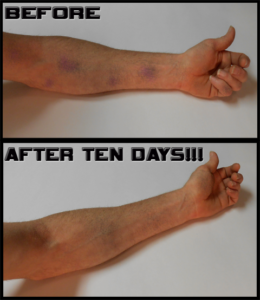 There are many people living with medical conditions such as diabetes, psoriasis, eczema, cellulitis, that have to take blood thinners or have thin skin from steroid use or too much exposure to the sun. One of the problems that is common among people with these conditions is easy bruising and tearing of the skin. If you have any of these conditions especially diabetes you are at a much higher risk of picking up a serious infection from even the smallest scratch. Your arms are the most common place to bruise or scratch yourself while doing everyday task. Why is easy bruising so common in older adults? Some people especially women are more prone to bruising than are others. As you get older, several factors can contribute to easy bruising, including:
There are many people living with medical conditions such as diabetes, psoriasis, eczema, cellulitis, that have to take blood thinners or have thin skin from steroid use or too much exposure to the sun. One of the problems that is common among people with these conditions is easy bruising and tearing of the skin. If you have any of these conditions especially diabetes you are at a much higher risk of picking up a serious infection from even the smallest scratch. Your arms are the most common place to bruise or scratch yourself while doing everyday task. Why is easy bruising so common in older adults? Some people especially women are more prone to bruising than are others. As you get older, several factors can contribute to easy bruising, including: Aging capillaries: Over time, the tissues supporting these vessels weaken, and capillary walls become more fragile and prone to rupture.
Thinning skin: With age, your skin becomes thinner and loses some of the protective fatty layer that helps cushion your blood vessels from injury. Excessive exposure to the sun accelerates this process.
Blood-thinning drugs: such as aspirin and Warfarin (Coumadin) or medications such as Plavix reduce your blood’s ability to clot. The result of this is bleeding from capillary damage might take longer than usual to subside this allows enough blood to leak out and can cause a bruise.
Conditions that put you at a high risk of infection from cuts and scratches.
Diabetes:
Diabetes is a serious condition that, affects many systems in the body, including the immune system. Since the immune system helps protect the body from infection, diabetics often find that they develop more infections than people with healthy immune systems. Other factors also influence the development of infection in diabetics, such as neuropathy, nerve damage that results in decreased sensation. Neuropathy often makes scratches and cuts less noticeable to the diabetic, increasing the chance that an infection will worsen. Diabetics also experience decreased blood flow this raises infection risks in diabetics.
Cellulitis:
Cellulitis is a skin infection caused by bacteria. Normally, your skin helps protect you from infection. But if you have a cut, sore, or insect bite, bacteria can get into the skin and spread to deeper tissues. If it is not treated with antibiotics, the infection can spread to the blood or lymph nodes. This can be deadly.
Psoriasis:
Psoriasis is an immune-mediated disease that affects the skin. It is typically a lifelong condition. There is currently no cure, but various treatments can help to control the symptoms. Psoriasis occurs when the immune system mistakes a normal skin cell for a pathogen, and sends out faulty signals that cause overproduction of new skin cells. People with psoriasis often notice new lesions 10 to 14 days after the skin is cut, scratched, rubbed, or severely sunburned. This is called the “Koebner phenomenon” and is named after Dr. Koebner who in the 19th century observed that a patient developed new lesions in areas where his horse bit him. Today, a wide range of traumas and skin conditions are known to trigger Koebner’s phenomenon including cuts, scratches, skin tears and scraps Research shows that about 50% of people with psoriasis experience the Koebner phenomenon.
Eczema:
The term eczema is broadly applied to a range of persistent skin conditions. These include dryness and recurring skin rashes that are characterized by one or more of these symptoms: redness, skin edema (swelling), itching and dryness, crusting, flaking, blistering, cracking, oozing, or bleeding. Areas of temporary skin discoloration may appear and are sometimes due to healed injuries. Scratching open a healing lesion may result in scarring and may enlarge the rash. People with atopic eczema have an impaired ability to deal with infection. Also, as we know all too well from practical experience, eczema itches and the natural responses to itch is to scratch. This in turn causes the skin to crack and split and become sore, inflamed and moist – a perfect breeding ground for bacteria.
